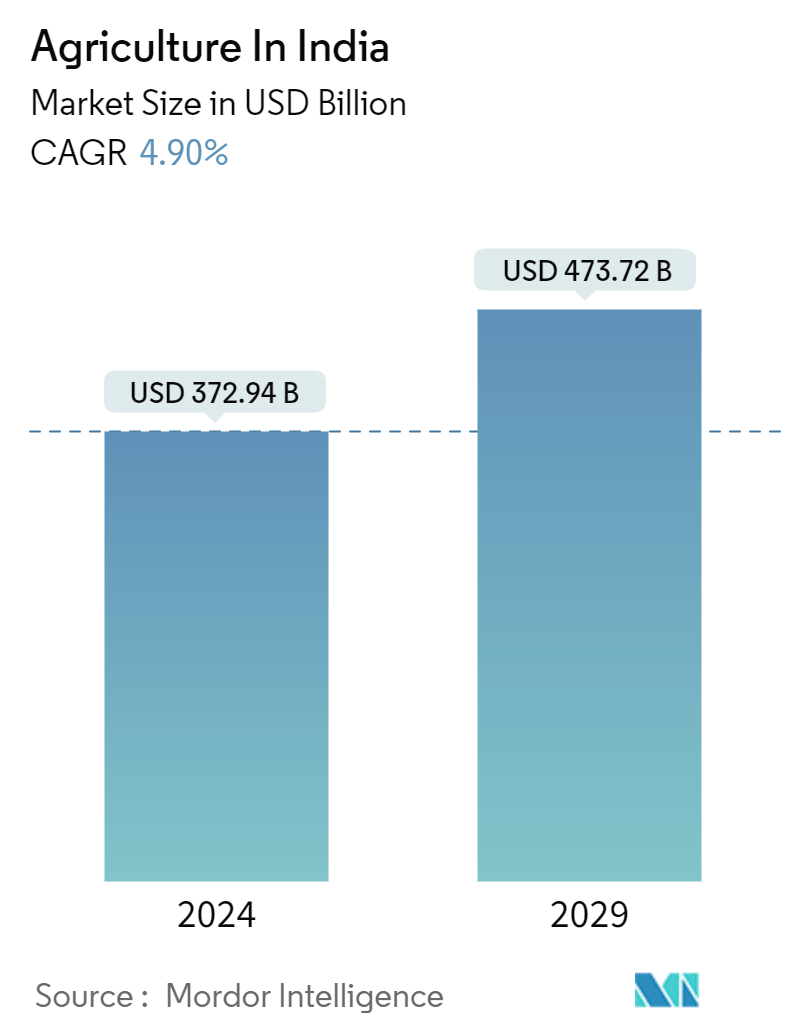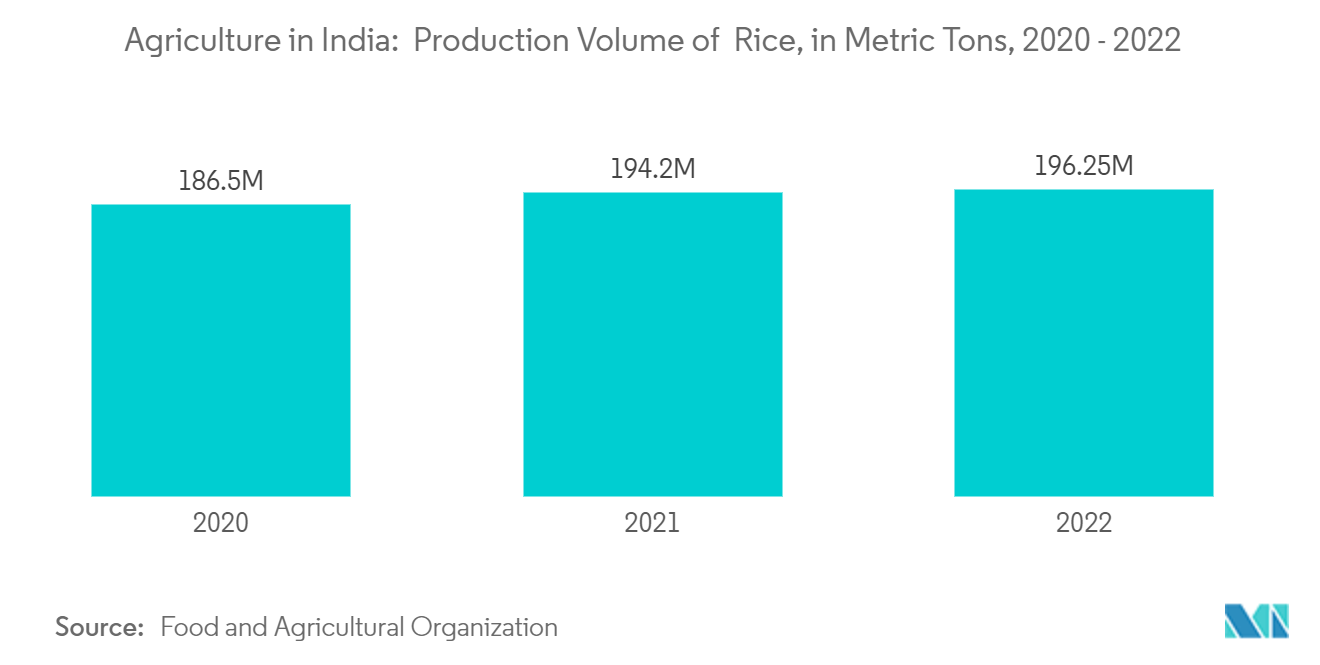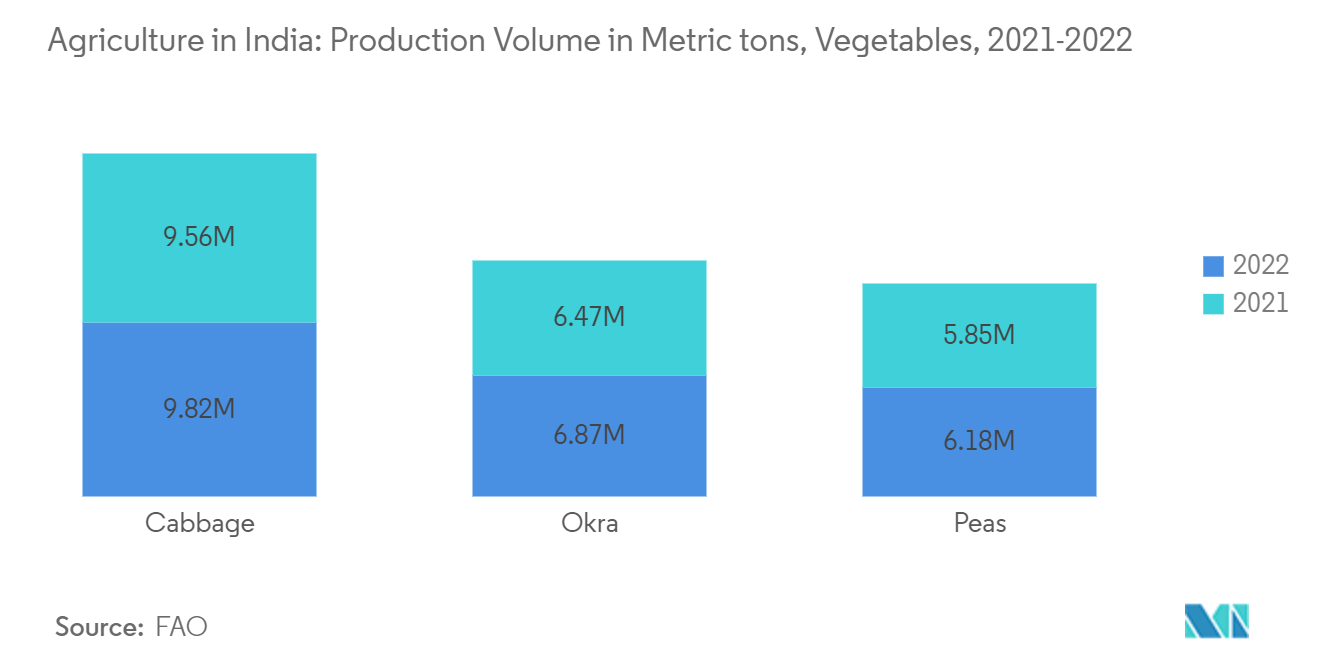India Agriculture Market Size

| Study Period | 2019 - 2029 |
| Base Year For Estimation | 2023 |
| Forecast Data Period | 2024 - 2029 |
| Market Size (2024) | USD 372.94 Billion |
| Market Size (2029) | USD 473.72 Billion |
| CAGR (2024 - 2029) | 4.90 % |
Major Players*Disclaimer: Major Players sorted in no particular order |
Need a report that reflects how COVID-19 has impacted this market and its growth?
India Agriculture Market Analysis
The Agriculture In India Market size is estimated at USD 372.94 billion in 2024, and is expected to reach USD 473.72 billion by 2029, growing at a CAGR of 4.90% during the forecast period (2024-2029).
- The agriculture market in India is a critical industry, contributing significantly to the nation’s GDP and employment. As of 2024, agriculture continues to be a cornerstone of the Indian economy, engaging around 45% of the workforce and contributing approximately 18% to the country's GDP. The industry encompasses a diverse range of activities, including crop cultivation and horticulture. India is one of the largest producers of various crops, including rice, wheat, sugarcane, and pulses, and holds a significant position in global agricultural markets.
- In recent years, the Indian agriculture sector has undergone substantial transformations driven by technological advancements, government policies, and market dynamics. The introduction of new agricultural practices and modern technologies, such as precision farming, has enhanced productivity and sustainability. Additionally, government initiatives such as the Pradhan Mantri Krishi Sinchai Yojana (PMKSY) and the Digital India Land Records Modernization Programme (DILRMP) have played a pivotal role in improving irrigation facilities and land record management.
- The Union Budget for 2023-2024 strongly emphasizes regenerative agriculture, inclusive growth, enhanced access to agricultural credit, high-quality agricultural inputs, digitization, and technological advancement. Consequently, the increase in sustainable farming practices, government initiatives, and the drive to improve crop productivity through extension services are anticipated to propel the market's growth during the forecast period.
India Agriculture Market Trends
Cereals and Food Grains is Leading the Agriculture Market in India
Cereal and food grains are crucial to the Indian agriculture market. They are a significant part of the diet for most Indians and make a substantial contribution to the country's agricultural GDP. India is one of the world's largest producers of rice, wheat, and coarse cereals. According to the Food and Agriculture Organization (FAO), cereal production increased from 325.1 million metric tons in 2019 to 355.1 million metric tons in 2022.
India is the largest producer and exporter of cereal products in the world. During 2023-2024, India's export of cereals accounted for INR 90,961.67 crore (USD 10,984.27 million). Rice, including basmati and non-basmati, accounted for 95% of India's total cereals export in value terms during the same period. According to the Food & Agricultural Organisation (FAO), India is the world's largest producer of millets (38.40% of world production), the second-largest producer of rice (25.27% of global production) and wheat (13.33% of world production), and the fifth largest producer of maize (2.9% of world production). The domestic consumption of these grains is robust, driven by a large and growing population. Rice and wheat are staple foods across various regions, with rice predominantly consumed in southern and eastern states and wheat in northern and western states. The per capita consumption of these grains is high, emphasizing their importance in Indians' daily diet.

Increasing Demand for Fruits and Vegetables
According to the Indian Council of Agricultural Research (ICAR), increasing awareness regarding the consumption of fruits and vegetables to meet various dietary requirements and nutritional needs has raised the demand for vegetables, consequently leading to an increase in the area under production (from 15.5 million ha in 2019 to 16.7 million ha in 2022). According to FAO (2022), India was identified as the largest producer of ginger and okra among vegetables and the second-largest producer of potato, onion, cauliflower, brinjal, cabbage, etc. India is the second-largest producer of vegetables globally, accounting for 15% of the world's production. The country's production of vegetables and fruits increased from 236 million metric tons in 2019 to 256 million metric tons in 2022. This indicates the expanding supply and consumption pattern of vegetables, which is expected to further fuel the demand in the market in the coming years.
Government initiatives have been pivotal in boosting the agricultural market for fruits and vegetables. The Mission for Integrated Development of Horticulture (MIDH) provides financial aid to farmers, enhancing production quality and quantity. Additionally, investments in cold storage and supply chain infrastructure, driven by the Ministry of Food Processing Industries (MoFPI), reduce post-harvest losses and ensure fresh produce reaches markets more efficiently.
To meet the increasing demand, farmers are diversifying their crops by growing a variety of vegetables. These short-duration crops yield multiple harvests, leading to improved cash flow for the farmers. In February 2022, Punjab Agricultural University in Ludhiana introduced new varieties of strawberries, figs, date palms, grapes, broccoli, Chinese cabbage, celery, lettuce, sweet peppers, and baby corn. These can be grown by farmers for both consumer markets and personal consumption.

India Agriculture Market News
August 2024: The Indian government launched a new digital geospatial platform called Krishi-Decision Support System (Krishi-DSS). This platform offers seamless access to comprehensive all-India data, including satellite images of farms, weather information, water reservoir storage, groundwater levels, and soil health information.
July 2024: The Indian Council of Agricultural Research (ICAR) signed a memorandum of understanding (MoU) with Syngenta Foundation India (SFI) and Syngenta India Pvt. Ltd to promote climate-resilient agriculture and training programs.
November 2022: Israel opened two Centers of Excellence (CoE) in the Jammu division and the Kashmir valley in India as part of the Indo-Israel Agriculture Project (IIAP). The goal of this initiative is to promote farmers' adoption of advanced technology to enhance crop productivity.
November 2022: Microsoft Research launched a Center of Excellence for the Microsoft Farmvibes.ai project in Baramati. In collaboration with the Agricultural Development Trust, Atal Incubation Centre, and Oxford University's Artificial Intelligence for Agriculture Technology and Climate Change, this initiative seeks to promote sustainable agricultural practices using data-driven farming and advanced technologies.
India Agriculture Market Report - Table of Contents
1. INTRODUCTION
- 1.1 Study Assumption and Market Definition
- 1.2 Scope of the Study
2. RESEARCH METHODOLOGY
3. EXECUTIVE SUMMARY
4. MARKET DYNAMICS
- 4.1 Market Overview
- 4.2 Market Drivers
- 4.3 Market Restraints
- 4.4 Value Chain Analysis
5. MARKET SEGMENTATION (Production Analysis by Volume, Consumption Analysis by Volume and Value, Import Analysis by Volume and Value, Export Analysis by Volume and Value, and Price Trend Analysis)
-
5.1 Food Crops/Cereals
- 5.1.1 Rice
- 5.1.2 Wheat
- 5.1.3 Sorghum
- 5.1.4 Millet
- 5.1.5 Barley
-
5.2 Fruits
- 5.2.1 Banana
- 5.2.2 Mango
- 5.2.3 Orange
- 5.2.4 Papaya
- 5.2.5 Grapes
-
5.3 Oilseeds
- 5.3.1 Soybeans
- 5.3.2 Rapeseed
- 5.3.3 Groundnut
- 5.3.4 Castor
-
5.4 Vegetables
- 5.4.1 Potato
- 5.4.2 Onion and Shallot
- 5.4.3 Tomato
- 5.4.4 Eggplant
- 5.4.5 Cabbage
- 5.4.6 Cauliflower
6. REGIONAL ANALYSIS
- 6.1 PESTLE Analysis
- 6.2 Government Policies
7. COMPETITIVE LANDSCAPE
- 7.1 Distribution Network and Retail Analysis
- 7.2 List of Distributors/Traders
8. MARKET OPPORTUNITIES AND FUTURE TRENDS
** Subject To AvailablityIndia Agriculture Industry Segmentation
Agriculture is the practice of cultivating the soil, producing crops, and, in varying degrees, preparing and marketing the resulting crop products, such as fruits, vegetables, and cereal crops, in the country.
Agriculture in India is segmented into food crops/cereals (rice, wheat, sorghum, millet, and barley), oilseeds (soybean, rapeseed, groundnut, and castor), fruits (banana, mango, orange, papaya, and grapes), and vegetables (potato, onion and shallot, tomato, eggplant, cabbage, and cauliflower). The report includes the production analysis (volume), consumption analysis (value and volume), export analysis (value and volume), import analysis (value and volume), and price trend analysis for the market. The report offers market sizes and forecasts in terms of value (USD) and volume (metric tons).
| Food Crops/Cereals | Rice |
| Wheat | |
| Sorghum | |
| Millet | |
| Barley | |
| Fruits | Banana |
| Mango | |
| Orange | |
| Papaya | |
| Grapes | |
| Oilseeds | Soybeans |
| Rapeseed | |
| Groundnut | |
| Castor | |
| Vegetables | Potato |
| Onion and Shallot | |
| Tomato | |
| Eggplant | |
| Cabbage | |
| Cauliflower |
India Agriculture Market Research FAQs
How big is the Agriculture In India Market?
The Agriculture In India Market size is expected to reach USD 372.94 billion in 2024 and grow at a CAGR of 4.90% to reach USD 473.72 billion by 2029.
What is the current Agriculture In India Market size?
In 2024, the Agriculture In India Market size is expected to reach USD 372.94 billion.
What years does this Agriculture In India Market cover, and what was the market size in 2023?
In 2023, the Agriculture In India Market size was estimated at USD 354.67 billion. The report covers the Agriculture In India Market historical market size for years: 2019, 2020, 2021, 2022 and 2023. The report also forecasts the Agriculture In India Market size for years: 2024, 2025, 2026, 2027, 2028 and 2029.
Agriculture in India Industry Report
Statistics for the 2024 Agriculture in India market share, size and revenue growth rate, created by Mordor Intelligence™ Industry Reports. Agriculture in India analysis includes a market forecast outlook to 2029 and historical overview. Get a sample of this industry analysis as a free report PDF download.

